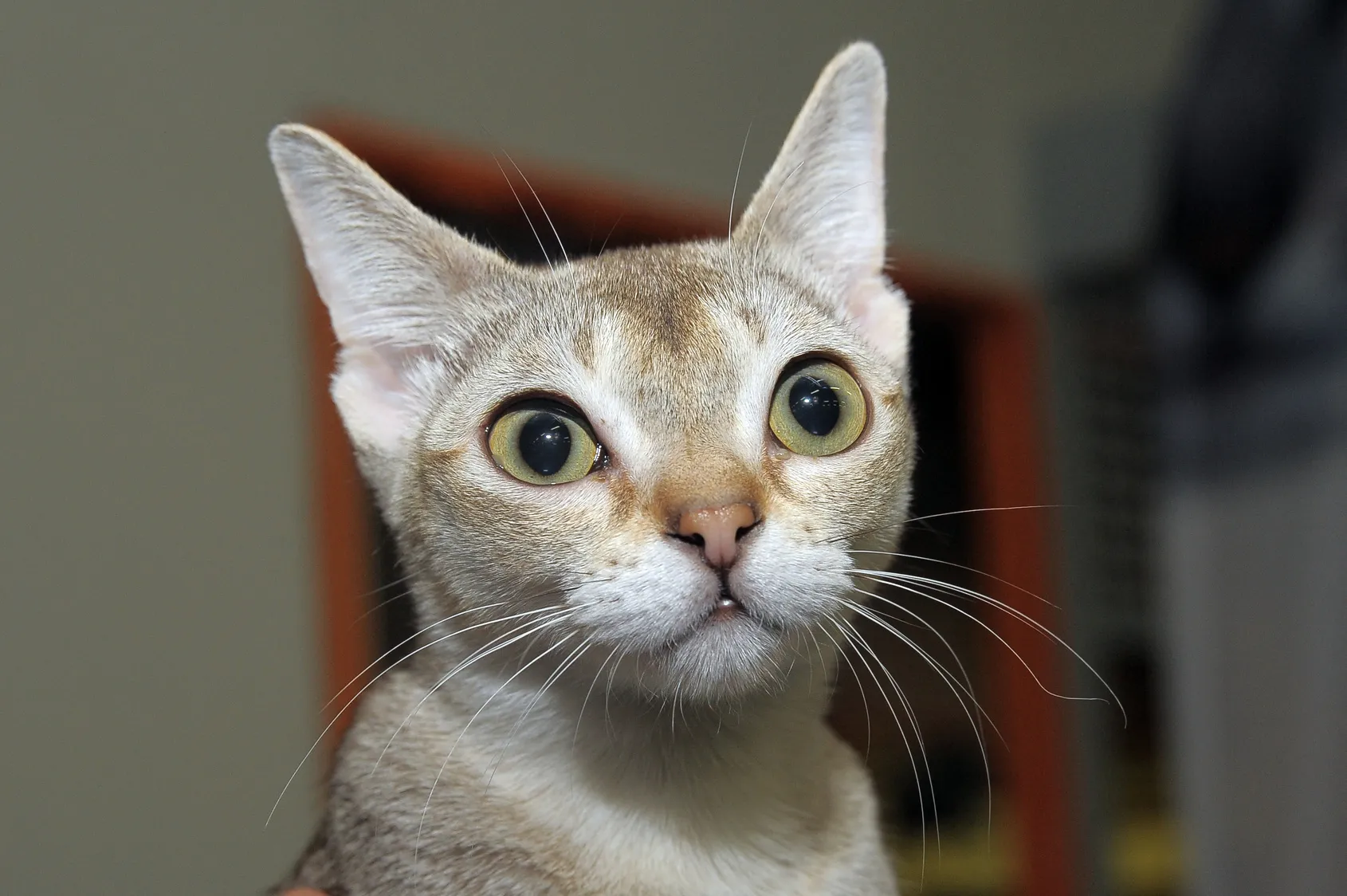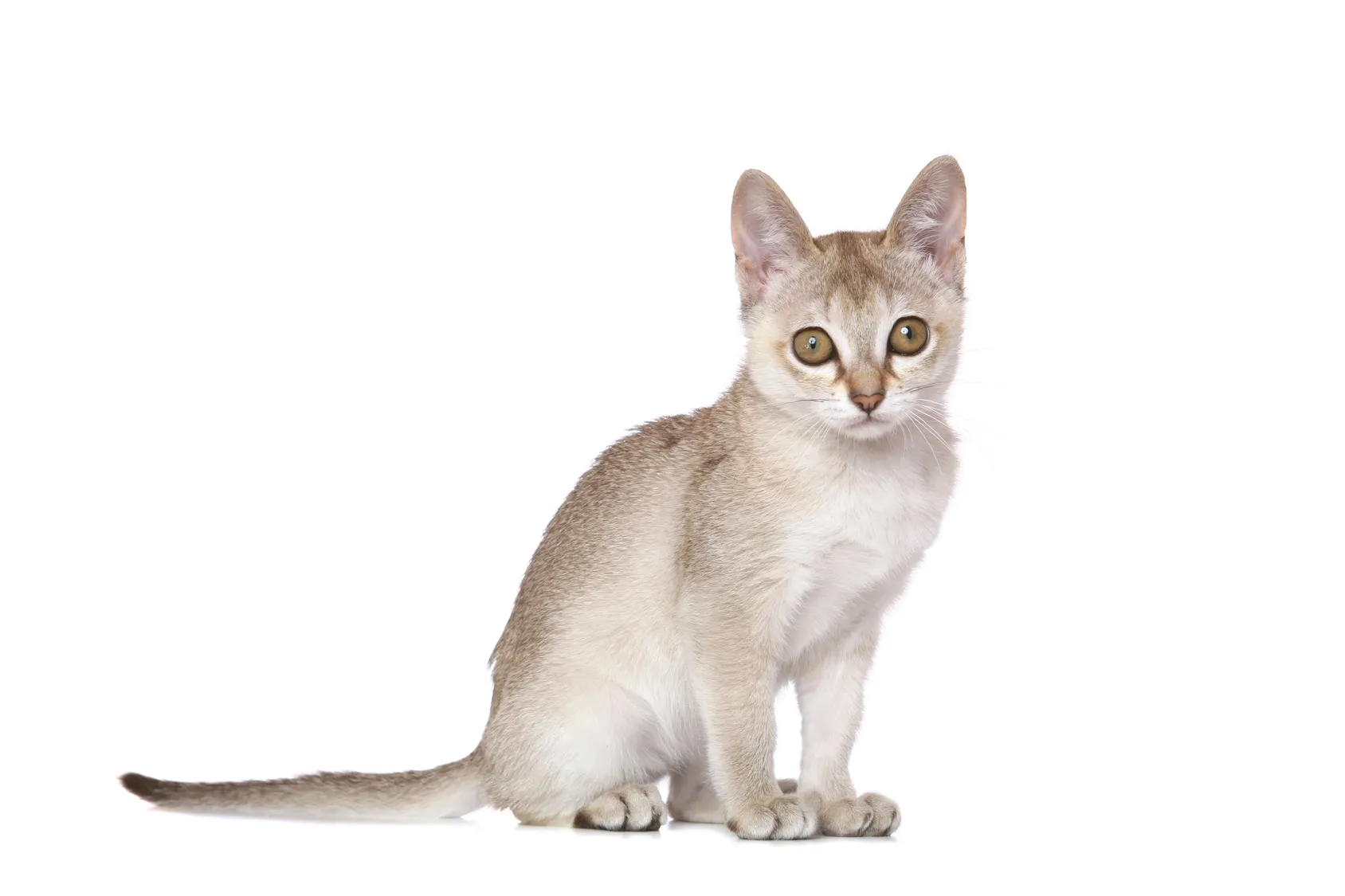Maine Coon
The Maine Coon has become one of the most popular cat breeds in the world. This is probably due to its majestic appearance, robust nature and great character.
The sweet Singapura is a real rarity, since the number of responsible breeders is still very low. As a result, it isn't at all easy to procure a cat belonging to this exotic breed. However, whoever is fortunate enough to give a Singapura a home can count themselves all the luckier, since these cats have a unique character that is both delightful and fascinating – just as your life alongside a Singapura will be.

© spiritofamerica / stock.adobe.com
The small heads of the rare sepia-coloured beauties is their main characteristic feature. Singapuras are classed as the smallest cat breed, weighing just two to three kilos. The weight difference between males and females is not particularly significant with Singapuras. Despite their dainty and graceful form, these exotic cats are distinguished by their strong, athletic physique with well-formed muscles. As a result, these little power packs are excellent jumpers. The Singapura only reaches its full size at 15 to 24 months.
Thanks to their sepia-coloured fur, Singapuras look like they have emerged straight from a photo from the 19th century. The exact and only officially recognised name of this fur colour is “sepia agouti”. Breeders call the banding of the fur “ticking”. The Singapura’s fur looks almost entirely monocolour, whilst the individual hairs vary between being dark and light in colour. The Singapura’s characteristic fur colour came about due to a mutation known as “partial albinism”, which causes “acromelanism”, the term used to describe the darker colouring of the cooler areas of the body.
This is how the darker coloured “points” emerge on the Singapura’s face, ears, legs and tail. Kittens are born light in colour and their fur only darkens later on. According to the standard, the fur of these rare and fascinating cats is only fully developed after two to three years. The fur has a slightly silky texture that just begs for you to stroke it regularly.
The tail of these exotic beauties is of an average length. Their eyes and ears are large and the ears have a wide base. The eyes are oval-shaped and can be green, brown, green-brown or yellow.
 © Evdoha / stock.adobe.com
© Evdoha / stock.adobe.com
If you’re lucky enough to have a rare Singapura living with you, it will probably be a little shy at first. Give it plenty of time to get settled and accustomed to your human housemates when it moves in. Singapuras are friendly towards strangers, though rather reserved at the beginning and need some time to break the ice. It is imperative to patiently and tactfully convince initially shy animals that you only have the best of intentions where they are concerned. Sweet Singapuras will thank you with their loving nature and enjoyable presence.
Once a Singapura trusts its owner, it will likely never leave their side, since cats of this breed are very drawn to people. Their sociable nature makes them a good addition to families. They also get on very well with other cats and what’s more, Singapuras need the company of their counterparts. Hence, you should absolutely keep the Singapura with other cats. They actually feel much more at ease when they are surrounded by other cats for playtime and cuddles. Humans who love their cats should definitely meet this need. These sepia-coloured cats are happiest in a family with children and multiple cats.
However, take into consideration that children need to act with caution around cats. Hence, it is recommended that you potentially only get a Singapura when your children are over the age of six. In contrast, the Singapura is not suitable for singletons working full-time away from home all day.
These noble exotic cats are talkative, playful, very intelligent and curious. They love being in the thick of things and are always up for fun. It has been said that some Singapuras “dance” on keyboards and the like. This rare breed maintains its playfulness and great intelligence well into old age. Singapuras reach an average age of 15 years.
In households with several cats, the felines should match in terms of their temperament. In order to get an idea of what cats could harmonise well with one another, you should consult individuals with whom the cats have lived previously – the breeder, animal home or former owner. They will be able to give you a precise assessment of which cats are compatible and suitable for living together in your home. Your own powers of observation and intuition can also be a reliable source of advice when making the decision. It’s generally recommended to take siblings, which makes the familiarisation phase easier for everyone – both the cats as well as the humans.
 © Krissi Lundgren / stock.adobe.com
© Krissi Lundgren / stock.adobe.com
“Singapura” means “Singapore” in Malay. According to most sources, this city state is considered the origin of this rare cat breed. However, there are controversial tales regarding the Singapura’s origin. Some sources claim that the Singapura comes from the US, whilst according to others they are from Singapore. Both are potentially right: the Singapura was probably discovered in 1970 in Singapore, known as the Lion City, by cat fans Hal and Tommy Meadow, two US expats. These cat lovers bred the Singapura from their own cats Ticle, Pusse, Tes, George, Gladys and Chiko and took it back to the US with them in 1975. This is how the Singapura reached the US from Singapore.
According to tradition, these small cats lived in narrow drain pipes in Singapore, thereby gaining the name “drain cats”.
Breeders put great focus on the Singapura being in good health and having a uniform appearance. However, this meant that a limited number of Singapuras enjoyed a high degree of acceptance and broad dissemination. Nowadays the breed is found worldwide. Since 1982, the Singapura has been recognised as a pedigree cat in the US and has been allowed to take part in competitions since 1988. At the end of the 1980s, the first cats from this exotic breed reached Europe and the UK. Since 2014, the Singapura has been officially recognised by FIFé (“Féderation Internationale Féline”), an international umbrella association for cat breeding.
In all likelihood, the Singapura is related to Siamese and Burmese cats.
The natural diet of carnivorous cats consists of prey animals like mice and other small animals, insects and birds. As a result, a diet consisting of raw or cooked meat would be closest to the natural nutrition of cats. However, not all required nutrients are contained in pure meat. In order to ensure that the Singapura’s specific dietary needs are met, it can be recommendable to boost its usual food with supplements. For instance, these contain vitamins, minerals, trace elements and taurine.
Each cat is fundamentally a creature in its own right and as such has its own preferences – also when it comes to food. It’s important to provide the right quantity, amongst other things. With their relatively active lifestyle, Singapuras tend to need more calories. The right amount of food has a positive effect on their whole physical condition. They moult less and if they benefit from a species-appropriate healthy diet, the condition of their fur is generally good.
 © coulanges / stock.adobe.com
© coulanges / stock.adobe.com
The amount of time and effort required for grooming a Singapura is very manageable. The short silky fur has no undercoat and they don’t moult much as short-haired cats. You should lovingly brush your feline friend around once a week to every few weeks. By doing so, you remove loose fur, encourage circulation and also prevent potential matting. What’s more, it strengthens the connection between you both!
Like all cats, Singapuras should only be vaccinated when their immune system is already built up. The same recommendations regarding vaccinations for all other cats also apply to Singapuras. Hence, you should get yours vaccinated against cat colds, panleukopenia and leukosis in particular, as well as rabies if it has outdoor access.
It’s important that you find out about the lineage of your feline housemate, primarily regarding hereditary diseases and genetic defects. Amongst other things, a sign of a responsible breeder is being able to give you information about the cat’s family tree. In most cases, Singapuras are between the age of 12 and 16 weeks when scrupulous breeders let them move into a new home. They will already have been dewormed and received basic immunisation at this point in time and will generally also be used to scratching trees and litter boxes. If this is not the case, you should be both loving and patient with the cute newcomer. Intelligent Singapuras learn quickly in principle and adapt well to the events in their surroundings.
“Kucinta”, the Malay nickname of this striking cat breed, is translated as “cat love”. And we are certain that anyone who has a Singapura will love the small cat with a big personality.
Here are some purchase proposals curated by the zooplus editorial team
The products featured have been carefully selected by our editorial staff and are available at the zooplus online pet shop. The selection does not constitute advertising for the mentioned brands.
The Maine Coon has become one of the most popular cat breeds in the world. This is probably due to its majestic appearance, robust nature and great character.
Large eyes and attentively upright ears instantly tell you a great deal about this charming breed of cat: Abyssinians are inquisitive and affectionate towards people.
With its long, dense fur, rounded ears, and intense stare, the Pallas Cat, or Manul, looks rather fluffy, yet somewhat dangerous. However, don't be fooled by its appearance—this is no petting zoo resident. The Manul is a wild animal and considered untameable.